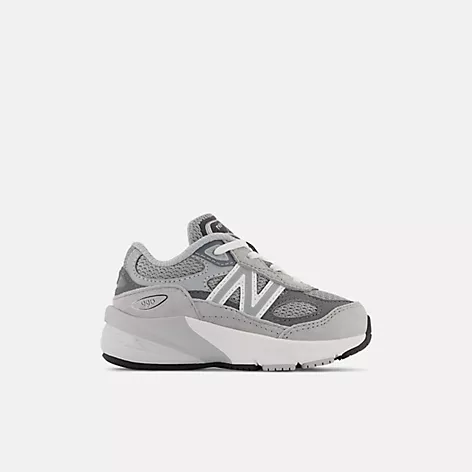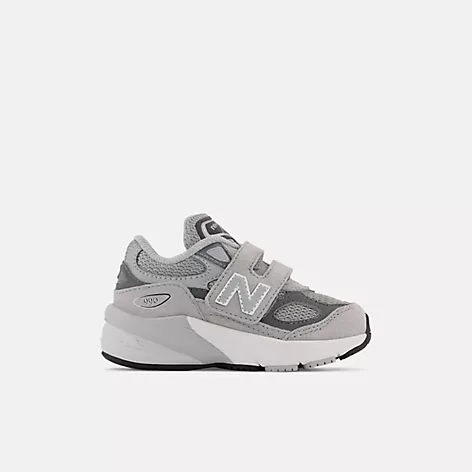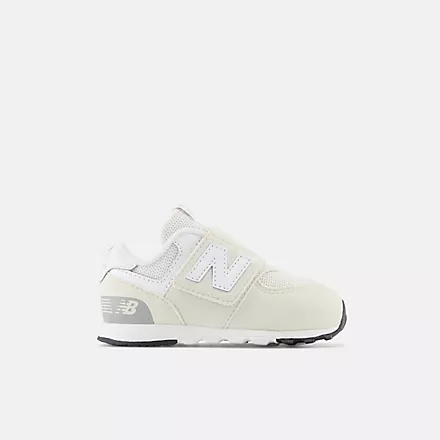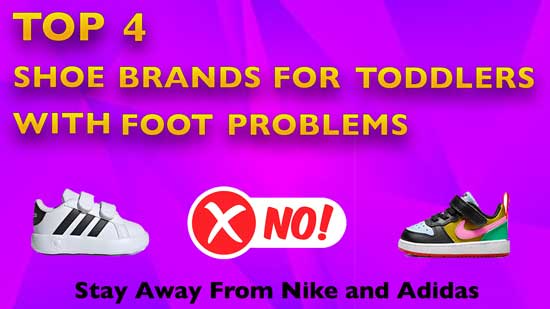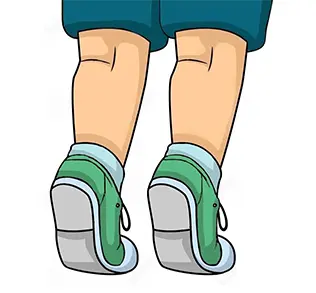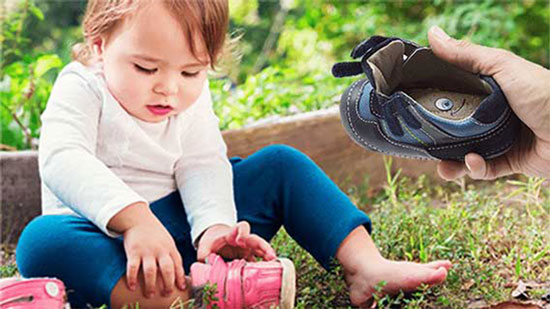Best Supportive Shoes for Toddlers – Substantial Outsoles and Firm Heel Counters!
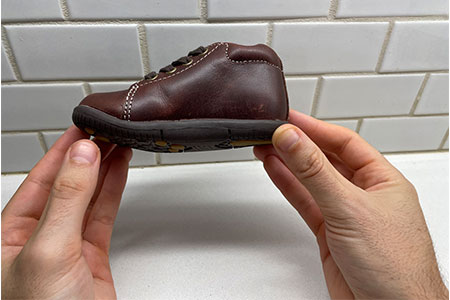
Is your toddler dealing with a specific foot condition and your medical professional advised to wear supportive shoes? Are you having a hard time finding a pair of shoes that provide good support and that are capable of fitting the shape of your toddler’s feet at the same time? The best supportive shoes for toddlers provide substantial outsoles, firm heel counters, and are lightweight and flexible at the same time.
Finding a pair of supportive shoes for toddlers is not easy, and it gets more challenging if your toddler has a “complicated” foot shape such as wide or extra wide feet.
Many physical and occupational therapists refer families to the store to have children fitted for supportive shoes and depending on the degree of their condition, orthotics as well.
I want to clarify a common misconception about supportive shoes. Supportive shoes won’t make your toddler’s muscles “lazy” or “weaker”. They simply provide structural support which is not going to take away from the musculature. This means that supportive shoes allow the child’s foot and leg muscles to develop on their own while supporting them.
Pro Tip: If you’re pressed for time, you can go straight to the selection of the best supportive shoes for toddlers.
How Did Our Feet Survive Before Supportive Shoes Came Around?
There is a common question asked by several families who are skeptical about whether supportive shoes can help treat their child’s foot condition: “How did our feet survive before all the supportive, better-made shoes came around”?
I believe that there have been advances in medicine and technology that have led us to live better, healthier lifestyles. The new opportunities in technology have made the whole shoemaking process a lot easier and simple.
There is an analogy I like to make when it comes to children wearing supportive shoes. When you have bad eyes, you wear glasses, does it cure your eyes? No, but it makes you see better, and you can function normally. Supportive shoes are like glasses for your child’s feet.
Shoes Should be Supportive but Lightweight and Flexible at the Same Time!
Toddlers tend to use a lot of energy walking so it’s important for the shoes to be lightweight and flexible. All of the shoes I recommend provide excellent support, but they are lightweight and flexible at the same time.
Shoes that are too heavy or stiff can make your toddler’s feet and legs tire easily. Your kids’ shoes should always bend at the ball of the foot but no further. If you can bend your toddler’s shoes like a spiral that means the shoe doesn’t provide the correct amount of support:
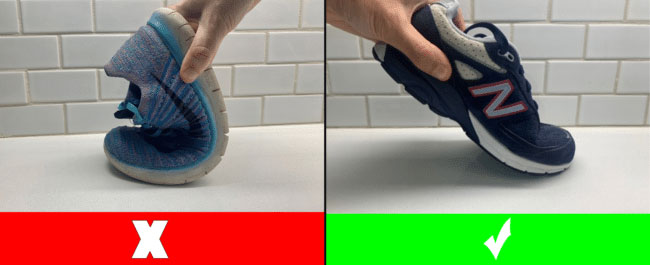
What Qualifies as Good Supportive Shoes?
There are two key features that the shoes need to provide to qualify as supportive shoes:
1️⃣ Substantial Outsoles: Shoes with substantial and supportive outsoles help support the feet and improve the toddler’s walking gait and overall posture. This feature is ideal for toddlers who are dealing with flat feet or rolled ankles.
Below you can see the difference between a shoe with a substantial outsole versus a shoe with an outsole that is too thin and doesn’t provide the correct amount of support:
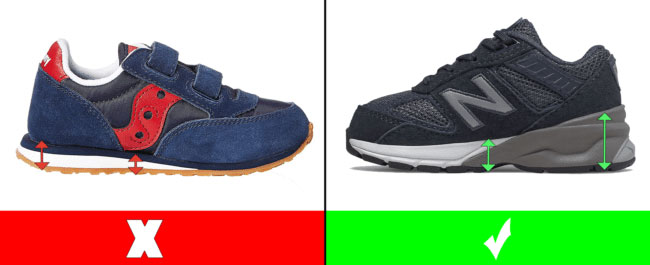
2️⃣ Firm Heel Counters: The heel counter is the back part of the shoe that provides ankle and heel support. The firmer the heel counter is the better ankle and heel support it provides.
Always make sure that the heel counter of your toddler’s shoes feels firm and sturdy. Let’s take a look at the difference between a shoe with a soft heel counter, and one with a firm heel counter.

What a Difference the Correct Type of Shoes Can Make!
The shoes I recommend have helped hundreds of children with flat feet, rolled ankles, low muscle tone, hypermobility, and other foot conditions.
Let’s take a look at an image of a flat-footed toddler standing barefoot. Do you notice how the toddler’s feet are collapsing and turning inwards? You should take a look at your toddler’s feet from behind to check if they look similar to this one.
Before Image
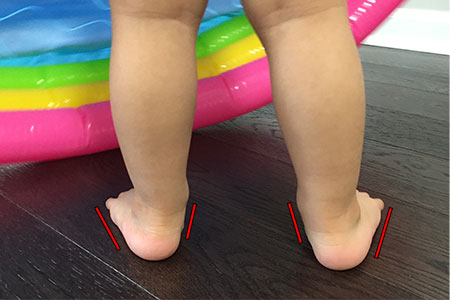
Now let’s see what happens when we fit that same child in a pair of supportive shoes I recommend. Do you notice how the child’s feet are a lot straighter? The substantial outsole and firm heel counter of the shoes are preventing the child’s feet from collapsing and turning inwards. The shoes are clearly improving the child’s foot posture.
After Image
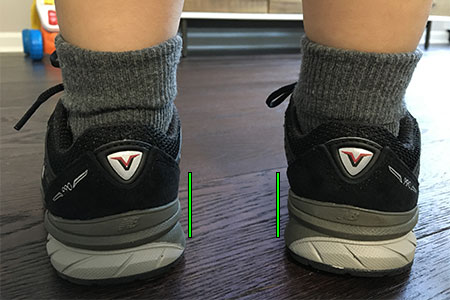
Before and After Image
Below you can see an example of a different child standing barefoot and wearing a pair of supportive shoes I recommend:
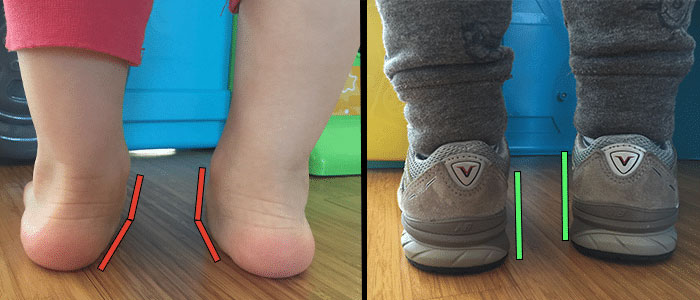
What a difference the correct type of shoes can make!
Before I show you a selection of shoes that provide these two features and that are lightweight and flexible at the same time, I want to make sure that you know your toddlers’ exact foot length and shape.
The Importance of Providing Your Toddler with the Correct Shoe Size
I have spoken with several pediatric physical therapists who are frustrated about children not wearing the correct type of shoes in the correct size.
These therapists explain to me how they encounter many children with physical disabilities who wear shoes that don’t fit properly, which makes the condition harder to manage.
One example was toe walking children that were wearing shoes too big for their feet. Shoes that are too big tend to slip off and children will often stay up on their toes as a way to help keep the shoe on their foot.
How to Retrieve Your Child’s Exact Foot Length and Shape
It’s clear that if you don’t order the correct size your child won’t get any of the benefits that the shoes have to offer. I created a free resource that helps parents determine their children’s exact foot length and shape by following two simple steps.
I have noticed throughout the years how wide feet in toddlers is common. I have seen that most toddlers tend to have wide or extra wide feet. That is the reason why all of the shoes I recommend are available in different widths such as medium (M), wide (W), and extra wide (XW). Keep in mind that shoes with shoelaces provide better support and stability compared to shoes with velcro closure.
Best Supportive Shoes for Toddlers
Check below the image of the shoe to find out what type of foot shape that specific style is capable of accommodating. Disclosure: Keep in mind that we may receive commissions when you click our links and make purchases.
Lace-Up Closure
- New Balance shoe style 990v6
- Fits toddlers with medium, wide, or extra wide feet
- Strong rubber outsole and cushioned midsoles
- Suede/mesh upper provides durability and breathability
- Order this shoe half a size larger than your toddler’s current foot size
- New Balance shoe style 990v6
- Fits toddlers with medium, wide, or extra wide feet
- Strong rubber outsole and cushioned midsoles
- Suede/mesh upper provides durability and breathability
- Order this shoe half a size larger than your toddler’s current foot size
- Stride Rite shoe style Emilia
- Fits toddlers with medium, wide, or extra wide feet
- Strong rubber outsole and a cushioned midsole
- 100% leather made
- Order this shoe a whole size larger than your toddler’s current foot size
- Stride RIte shoe style Elliot
- Fits toddlers with medium, wide, or extra wide feet
- 100% leather made
- Seamless construction that cradles the foot’s natural shape
- Order this shoe a whole size larger than your toddler’s current foot size
- Stride RIte shoe style Elliot
- Fits toddlers with medium, wide, or extra wide feet
- 100% leather made
- Seamless construction that cradles the foot’s natural shape
- Order this shoe a whole size larger than your toddler’s current foot size
- New Balance shoe style 990v6
- Fits toddlers with medium, wide, or extra wide feet
- Suede/mesh upper provides durability and breathability
- Order this shoe half a size larger than your toddler’s current foot size
- New Balance shoe style 2022
- Fits toddlers with medium or wide feet
- Suede/mesh upper provides durability and breathability
- Order this shoe half a size larger than your toddler’s current foot size
- New Balance shoe style 990v6
- Fits toddlers with medium, wide, or extra wide feet
- Strong rubber outsole and cushioned midsoles
- Suede/mesh upper provides durability and breathability
- Order this shoe half a size larger than your toddler’s current foot size
Velcro Closure
- Timberland Tracks H&L Boot
- Fits toddlers with medium or wide feet
- Breathable textile lining
- Stable base of support with firm heel counters
- Order this shoe a whole size larger than your toddler’s current foot size
- Saucony Cohesion
- Fits toddlers with medium or wide feet
- Heel grid system for stable cushioning
- Compression molded EVA footbed for comfort
- Order this shoe a whole size larger than your toddler’s current foot size
- New Balance style 990v6
- Fits toddlers with medium, wide, or extra wide feet
- ABZORB midsole absorbs impact through a combination of cushioning and compression resistance
- Removable insoles
- Extra deep
- Order this shoe a half size larger than your child’s current foot size
- New Balance style 574
- Fits toddlers with medium, wide, or extra wide feet
- Generous toe box and instep to accommodate and support your toddler walker’s needs
- Rubber outsole pods designed to stand up to daily wear and tear
- Extra deep
- Order this shoe a whole size larger than your toddler’s current foot size
- Memo style Gabi
- Fits toddlers with medium or wide feet
- Thermoplastic asymmetric stiff heel counter for proper feet protection and stabilization
- Stiff and high ankle support for toe walkers
- Order this shoe half a size larger than your toddler’s current foot size
- Memo style Gabi
- Fits toddlers with medium or wide feet
- Thermoplastic asymmetric stiff heel counter for proper feet protection and stabilization
- Stiff and high ankle support for toe walkers
- Order this shoe half a size larger than your toddler’s current foot size
- New Balance style 990v4
- Fits toddlers with medium or wide feet
- Generous toe box and instep to accommodate and support your toddler walker’s needs
- Extra deep
- Order this shoe a whole size larger than your toddler’s current foot size
Shoes fitted too long, too short, too narrow, or too wide, create a tread imbalance and a faulty wear pattern for the shoe itself. Do not hesitate to contact me if you are unsure about what shoe size to order for your toddler.
Shoelaces Vs Velcro Closure – Does it Make a Difference?
Shoelaces provide better support and stability compared to velcro closure. In addition, if your toddler needs to wear orthotics inside the shoe, I strongly suggest that you order a pair of shoes with shoelaces instead of velcro closure. The shoelaces will “hug” your child’s feet better, providing better support and stability and preventing the orthotic from moving excessively inside the shoes.
If your toddler needs to wear orthotics inside of the shoes, I suggest that you apply the following shoe lacing technique.
Final Thoughts on Supportive Shoes for Toddlers
Unfortunately, I have seen an increased number of families who buy shoes that are made of low-quality materials which provide little to non-existent support.
Just so you know, more expensive shoes don’t automatically translate into better shoes for your child. I have fitted very reasonable priced shoes that provide better support than the more expensive ones.
There is no universal shoe brand that works best for children with foot issues. I have found that there are specific shoes among each shoe brand that provide better support and structure than others, so don’t hesitate to contact me if you are in doubt about whether a specific shoe might work for your child or not.
There are so many choices shoe choices on the market that it can be very difficult for parents to choose one appropriate pair. I hope I made things easier for you by having put together a list of the best supportive shoes for toddlers.
Are Any Other Shoe Choices Available?
Don’t hesitate to contact me if you are looking for a different type of supportive shoe to help treat your child’s foot condition. Whether you are looking for seasonal shoes or dress shoes I will be able to guide you in the right direction. My email address is:


